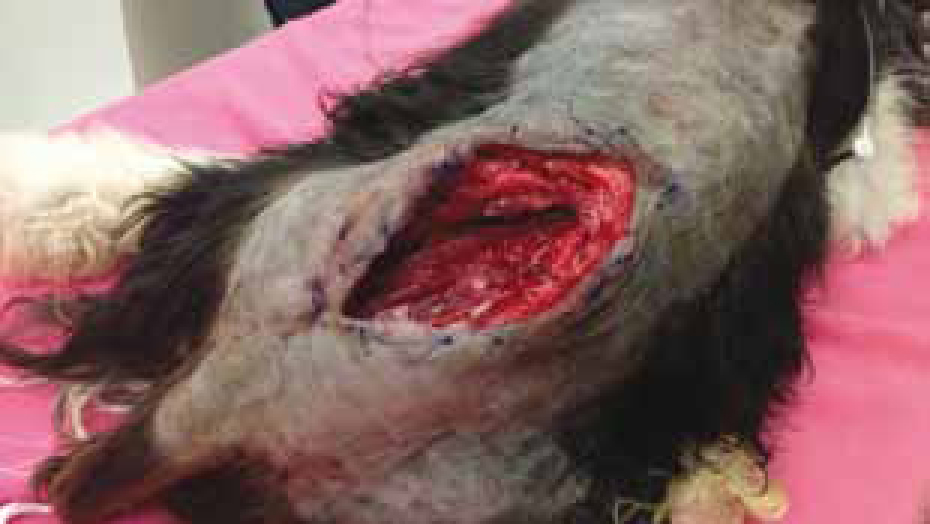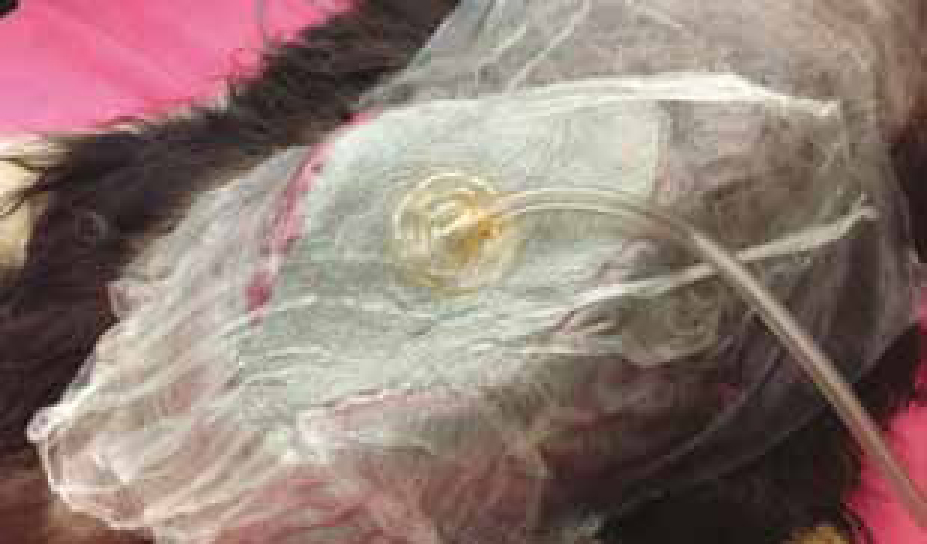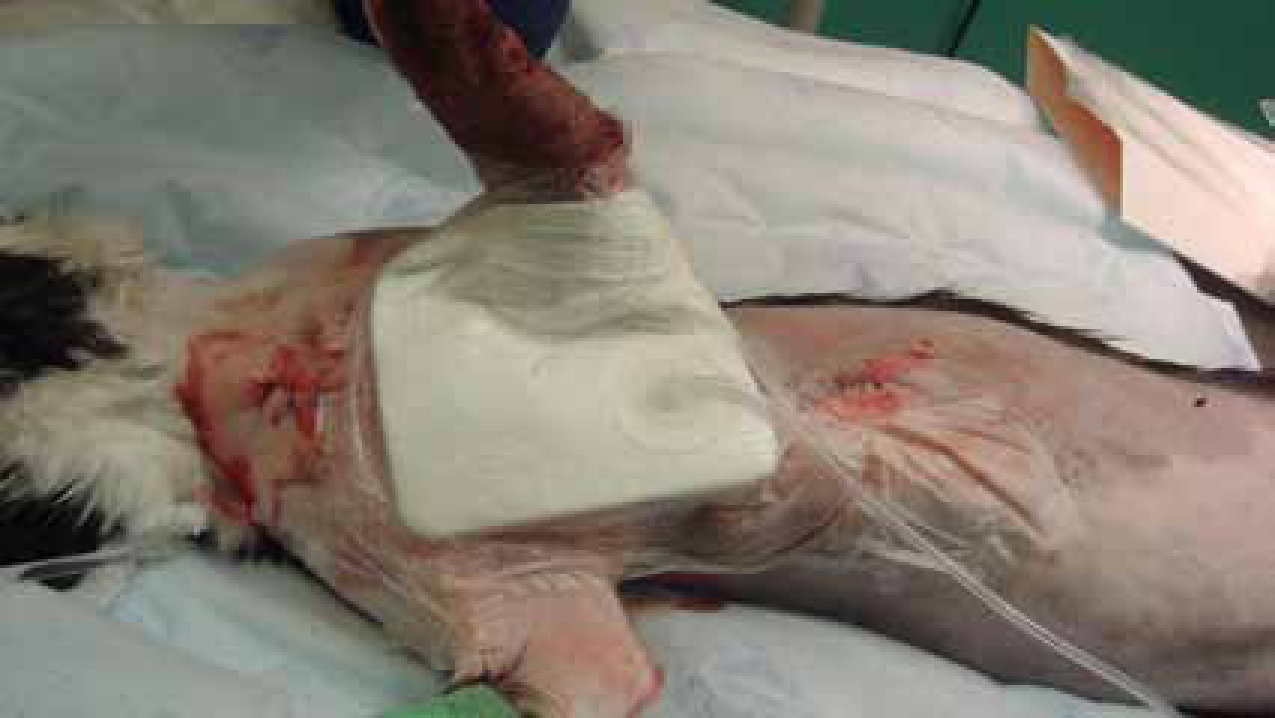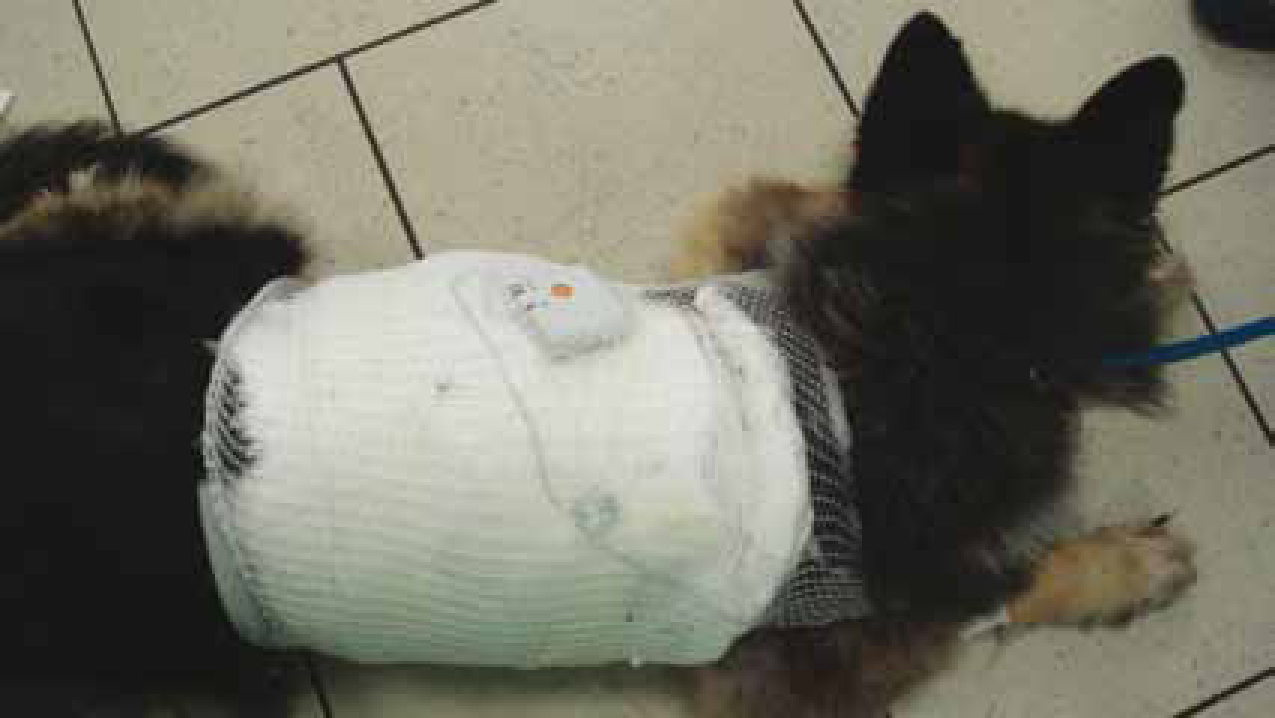Negative-pressure wound therapy (NPWT) is a noninvasive, active, closed, wound management system that exposes the wound bed to local subatmospheric pressure. Also referred to as vacuum-assisted closure (VAC), NPWT is used to stimulate granulation tissue formation, reduce interstitial oedema and inflammatory cytokines, and improve circulation while maintaining a moist wound-healing environment. In humans, NPWT therapy is used extensively to treat non-healing wounds (e.g. diabetic ulcers), burns, open fractures, and median sternotomy wounds (Argenta and Morykwas, 1997; Runkel et al, 2011; Demaria, 2011).
Indications and Contraindications
Indications for NPWT in animals include: treatment of large, open, contaminated wounds; dehisced surgical wounds, (with or without exposed orthopaedic implants or bones), degloving injuries and skin avulsions; chronic non healing wounds; and compartment syndrome (e.g. abdominal/myofascial) (Stanley, 2012).
NPWT wound care has also been used to prevent post-operative seroma or oedema formation and enhance skin graft re-epithelialisation (Perry and Witte, 2013a and 2013b). With this therapy, wound size and volume are reduced, skin graft acceptance enhanced, response to antibiotic therapy improved, and duration of open wound management reduced (ultimately reducing hospitalisation time and number of bandage changes) (Labler et al, 2004; DeFranzo et al, 2001).
NPWT is most efficacious during the proliferative stage of wound healing, but can be applied to almost any wound after appropriate debridement (Runkel et al, 2011). To eliminate a potential nidus for bacterial growth and prevent proliferation of granulation tissue over necrotic tissue (which could result in delayed wound healing and abscess formation), devitalised tissue should be removed before NPWT therapy is initiated (Wallis, 2010). NPWT wound care is contraindicated when neoplasia is present at the wound site and should not be used as sole therapy for osteomyelitis (Timmers et al, 2009). Severe haemorrhage may occur when NPWT is used on wounds with exposed arteries or veins, as these vessel walls could erode. NPWT should be used with caution in patients with coagulopathies (Stanley, 2012).
Advances in NPWT systems
Traditionally NPWT systems have consisted of foam or gauze, cut to the size of the wound bed. The foam should be of such a size that it fills the wound bed without overlapping the wound edges, and therefore the normal, healthy skin. This foam or gauze is then covered with an occlusive film type dressing, e.g. OpSite™, (Smith and Nephew) which creates an airtight seal. This is often one of the most difficult aspects of NPWT, as creating an airtight seal requires careful application of the dressing, and also preparation of the peri-wound skin. It is recommended by the author, that a 3–5 cm border of intact skin around the wound is used to adhere the dressing to. Finally a method of achieving negative pressure is required. This comprises evacuation tubing; this tubing is generally supplied by companies manufacturing NPWT systems. The evacuation tubing ends in a disc or footpad which anchors the tubing onto the occlusive dressing (Figures 1 and 2), a hole is made in the dressing through which the vacuum is applied. The vacuum is created using a specifically made external pump and canister, of which many brands are available, e.g. Renasys™, Smith and Nephew, V.A.C™ Therapy Unit, KCI.


The use of these units in reality can be very cumbersome, due to the size of the canister and unit required to achieve the negative pressure, therefore single-use units have been developed, which have made NPWT systems more portable, obviously a great advantage in human, and veterinary patients (Figure 3 and 4).


A small, portable pump system has been developed, the PICO™, (Smith and Nephew). This pump, despite its small size (pocket size), is able to generate an effective negative pressure of −80 mmHg, but can be attached to veterinary patients using a variety of techniques meaning, in the authors opinion, improved tolerance from patients and ease of use for veterinary staff.
The PICO pump is used with a specifically designed dressing, which works by maintaining negative pressure across the wound bed due to its occlusive film backing; it also removes exudate from the wound bed by absorption and evaporation (transpiration of moisture).
Mechanisms of action
Several mechanisms of action have been noted with NPWT, these include increased perfusion within the wound bed (Skagen and Henriksen, 1983); this arises due to a reduction in oedema which results in an increase in hydrostatic pressure, thereby increasing perfusion to the wound bed and surrounding area. Stimulation of granulation tissue also occurs (Morykwas et al, 2001) making its application particularly useful in extensive wounds. Reduced bacterial numbers are also reported, making the use of NPWT a consideration in infected wounds (Morykwas et al, 1997). The application of NPWT systems results in evenly distributed mechanical forces across the wound bed; this has an effect on the activity of cells within the wound bed, encouraging the migration of keratinocytes (Fenn and Butler, 2001), and stimulating angiogenesis (Urschel, 1988).
Considerations and complications
The most common pressure setting used in NPWT wound care is continuous pressure of −125 mmHg. When NPWT is used solely to diminish post-operative oedema or seroma formation on incision lines, pressure can be reduced to −50 to −75 mm Hg (Stanley, 2012). Application of intermittent negative pressure can improve blood flow and granulation tissue formation but in humans has reportedly caused discomfort (Morykwas et al, 1997). Frequency of bandage changes is determined by wound characteristics; NPWT bandages are typically changed every 48–72 hours, with more frequent changes early in the process to allow appropriate debridement (Argenta and Morykwas, 1997; Perry and Witte, 2013b). An airtight seal is essential to maintain continuous negative pressure and prevent wound desiccation (Stanley, 2012).
Complications of NPWT wound care are generally minor but can include loss of an airtight seal and local dermatitis associated with removal of the adhesive drape. If multiple NPWT bandage changes are necessary, the foam can be removed by cutting the plastic drape and leaving a portion of the drape adhered to the skin. Doing so can decrease skin irritation and may eliminate the need for sedation (Hodshon et al, 2012).
Conclusion
Vacuum-assisted wound closure is an excellent tool in human and veterinary medicine for dealing with complicated wounds and wounds in patients with co-morbidities. However, it is not a substitute for initial diligent wound management. As we learn more about the appropriate indications and techniques for veterinary medicine, it shows great promise for an expanded role in the future.

